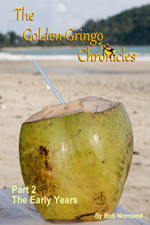The Golden Gringo and the entire staff at GGC Publications (guess who that is) wish you and yours every blessing and good wish for the new year.
¡Feliz Ano Neuvo Amigos!
Broken News
(All the News That's Fit to Reprint)
World Court Rules for Costa Rica
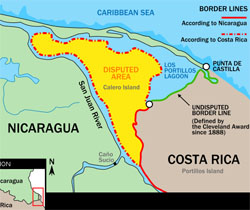 It's been over five years since Nicaragua invaded the small island of Calero in the northeast corner of Costa Rica. Ostensibly a "dredging operation" it turned out to be a bold attempt, some would say aggression, to cut a new channel mouth for the San Juan river across Costa Rican territory. Plans were later announced that Nicaragua would build a canal across the country to compete with the Panama Canal and that it would utilize the new mouth at the San Juan as well as the river itself and Lake Nicaragua.
It's been over five years since Nicaragua invaded the small island of Calero in the northeast corner of Costa Rica. Ostensibly a "dredging operation" it turned out to be a bold attempt, some would say aggression, to cut a new channel mouth for the San Juan river across Costa Rican territory. Plans were later announced that Nicaragua would build a canal across the country to compete with the Panama Canal and that it would utilize the new mouth at the San Juan as well as the river itself and Lake Nicaragua.
Shortly after the invasion, Costa Rica filed a complaint with the World Court in the Hague which was ruled on this week in Costa Rica's favor. The conclusion comes from a review of an historical treaty going back to 1858, established by U.S. president Grover Cleveland, known as the Cleveland Award. The ruling makes it indisputable that the boundaries in existence for over 150 years include Isla Calero which means that the area invaded was Costa Rican national territory.
So Costa Rica is in the right but it may be a Pyrrhic victory. The court failed to penalize Nicaragua in any way nor demand that they return the territory. The court even threw the compensation question back at the two parties "requiring" them to negotiate and report back in one year. Back when the suit at the World Court was first brought, Danny Ortega, the president of Nicaragua said more than once that he wouldn't be subject to any decision by the court anyway.
Sounds to GG like the Nicas are going to get away with island robbery, canal or no canal.
Cubans Dilemma
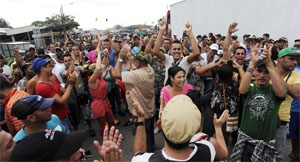 |
Cuban Emigres Rally at La Cruz Shelter |
The Chronicles reported on the growing Cuban emigre crisis in Costa Rica and Central America last month in Porous Perimeters. By mid-December, the number of Cuban emigres in Costa Rica with "temporary" transit visas was approaching 6,000 and they were being housed in 26 shelters primarily in or near the northwestern town of La Cruz near the Nicaraguan border.
The favorable outcome for Costa Rica was to have allowed the emigres to transit to Nicaragua on 7-day transit visas and then through other Central American countries to the north before reaching Mexico and then (supposedly) the United States. But Nicaragua, which represents the entire northern border contiguous with Costa Rica, had already refused entry to the Cubans so they got stuck here.
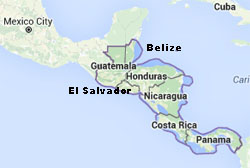 In December the problem got worse when Belize and Guatemala joined Nicaragua with a not-welcome-here policy of its own. Actually they were saying that there needs to be a regional solution to the problem before they agree, whatever that means. With Nicaragua cutting off land access from the south and Belize/Guatemala blocking exit to the north, use of El Salvador and/or Honduras becomes a moot point, at least by land routes (see map).
In December the problem got worse when Belize and Guatemala joined Nicaragua with a not-welcome-here policy of its own. Actually they were saying that there needs to be a regional solution to the problem before they agree, whatever that means. With Nicaragua cutting off land access from the south and Belize/Guatemala blocking exit to the north, use of El Salvador and/or Honduras becomes a moot point, at least by land routes (see map).
Mexico continues to say it will provide 10-15 day transit visas for the group but only if they come by land (not sea or air), reinforcing the need for Belize and Guatemala to agree to the program. Costa Rica's latino central american brothers keep shifting their positions and sure don't seem to be making it easy for anyone.
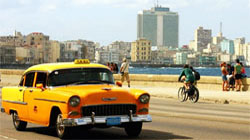 |
Havana - 2015 |
GG has questions. With regard to the Cubans, whatever happened to the old let's-overload-a-boat program and sail 90 miles from Cuba to Miami? If the U.S. is turning back emigres by sea why is everyone assuming it's OK to violate the border by land or is everyone just assuming that the Mexican border is so porous it will be easy to sneak in another 6,000 Cubans to the U.S.?
There have been several press reports that say these travelers are not political refugees but simply economic emigres seeking a better standard of life. I guess they got tired of waiting for the communist economic nirvana they've been promised. A typical monthly Cuban wage currently is $10-15, while an orthopedic surgeon might make as much as $60 per month (whoopee). A publication here, QCostaRica, recently offered up a video put together by an independent film maker called "Cuba Lost In Time Warp". It's like looking at a 1950's travel brochure but it's actually Cuba today.
The video made me want to visit Cuba if for no other reason than to enjoy seeing a whole bunch of cars I grew up with in the 1950's (check out that '55 Chevy in the photo above). My two closest friends in high school had a '55 Chevy and a '56 Ford and I had a '52 Studebaker that I bought for $90 in a junk yard. That's at least six months wages in Cuba currently. (♫ those were the days my friend, I thought they'd never end...♫)
Latest Updates:
On December 20: Casa Presidential, the office of the president of Costa Rica announced that Costa Rica will no longer issue temporary or transit visas to Cubans, effectively closing the southern border to them from Panama: “The national capacity to address the migrants has reached its limit. Costa Rica urges the Cuban people not to attempt irregular migration entering Costa Rican territory (sneaking in) and those caught in the attempt will be deported to Cuba immediately” said President Solis.
On December 23, TODAY NICARAGUA (Reuters) reported that the Nicaraguan government has proposed that the United States fly out thousands of Cuban migrants who have been stranded for several weeks on the Costa Rican border with Nicaragua. The Minister of Foreign Affairs said the U.S. has the “capacity as well as the technical and financial resources” to transport the Cubans directly to U.S. territory. More Pontius Pilate politics.
In El Salvador, Costa Rican president Solis withdrew from the regional summit talks, SICA (Sistema de la Integración Centroamericana) being held there because they failed to include the topic on their agenda. So a regional solution seems to be off the table.
Sounds like we're going to eventually have 5-6,000 new Spanish-speaking residents in Ticoland - and maybe a few new good Cuban restaurants.
On December 27 QCosta Rica reported that 56 Cuban immigrants were found and detained who did not have even the 7-day transit visas and will be deported to Cuba. By law, the government must provide two custodians for every deportee so the cost alone of one-way tickets on Cubana Airlines, the only one operating between San José and Havana, will come to around $108,000 assuming the custodians fly round trip.
On December 29, Costa Rica announced that a breakthrough had occurred at another meeting in Guatemala attended by five of the seven countries of Central America (Costa Rica, Panama, El Salvador, Honduras and Guatemala - only Belize and Nicaragua not attending). To wit: that El Salvador is now ready to receive the emigres by air and put them on a bus to Mexico. The only problem is that that strategy requires land passage through Guatemala and the Guatemalans have not yet agreed to that.
More to be revealed.
Sharks and Ice
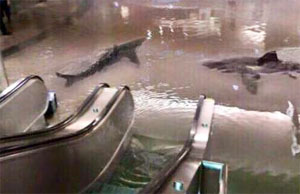 The opening of a major mall in the Central Valley, the City Mall, was announced in the press recently with a flourish. The City Mall is actually located in Alejuela, not in San José proper. It is not unusual for a large new enterprise to have a number of physical start-up quirks to overcome and City Mall followed tradition. Here are the issues that are still being worked on at City Mall.
The opening of a major mall in the Central Valley, the City Mall, was announced in the press recently with a flourish. The City Mall is actually located in Alejuela, not in San José proper. It is not unusual for a large new enterprise to have a number of physical start-up quirks to overcome and City Mall followed tradition. Here are the issues that are still being worked on at City Mall.
 |
Christmas Tree at City Mall |
One of the early problems occurred after some heavy rains hit the central valley near the end of the rainy season. The basement parking garage at City Mall flooded. Some pundits took the opportunity to make the incident into a joke and produced the spoof photo above showing sharks cruising the parking garage. ¡Por Dios!
Other start-up problems included low occupancy rate (some say not much more than 50%), and promised features that did not open on time, like a modern theater and a play park for kids. Doesn't sound to GG like that kind of thing is a big deal and that those problems should eventually be worked out.
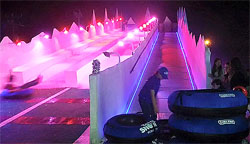 |
"Snowfun" Park |
Another thing mentioned in press reports was a lukewarm reception by mall goers to a new, indoor attraction called "Snowfun Park". At Snowfun, people were supposed to be able to see snow made and go snow tubing on a slide as well as have snowball fights and make snowmen. Now remember, the great majority of Costa Ricans have never seen real snow; not even at the top of their highest mountain, called Chíripo, although a flurry or two has occasionally been reported there.
Apparently what they got at Snowfun Park was basically ice, not snow. But that's OK, there still was enough time to get the large (artificial) Christmas tree up in the center of the mall. Feliz Navidad, amigos.
Costa Rican Hockey Team
Lack of a natural habitat in which to play certain games or sports doesn't discourage some folks from doing it anyway, just ask the Jamaican Bobsled Team.
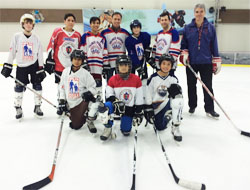 |
"Castillo Knights" Hockey Team
Coach Bruce Callow, Far Right |
Likewise, GG was surprised to learn that there is a team of stalwart hockey players in Costa Rica located in San Rafael de Heredia, some 40 kilometers, as the puck flies, northwest of San José. The team made the press recently when a California hockey fan visited them, came away impressed and ended up organizing a donation of some $1,500 in equipment that included 32 modern, lightweight hockey sticks. GG remembers playing hockey in New England back in the fifties (that's the 1950's for you yootes out there) with heavy wooden sticks that often broke. I also took a puck in the nose once; my buddies said it improved my looks.
The Costa Rica hockey team was founded in 1996 and became known as the Castillo Knights. They play in an ice rink located at the Castillo Country Club in San Rafael that is reported to be the only ice rink in Central America. The ice rink was originally constructed for pleasure skating but it was doubled in size last year and is now very suitable for a hockey game. Bruce Callow, in the blue jacket in the photo above right and the head team coach, is a Canadian transplant who jumped at the chance to help the Knights organize originally and who continues to be a major force in the team's success and growth.
Update 15 December from Coach Callow: A new temporary ice field was just inaugurated next to the National Stadium in La Sabana. Hockey games are being played there over the next four weeks and Coach Callow will be giving classes. Watch out NHL, it's only a matter of time.
Kids (aged 7 to 50!) play on the team and Ticos that have joined the Knights take to it quickly. That may be because of the similarities between hockey and futbol (i.e., soccer to the uninitiated). GG has noticed the similarity while watching futbol players at his neighborhood futsal (indoor futbol field). The best teams, and highest scores, are realized where teammates are well aware of their teammates positions, pass well and anticipate where they need to be in order set up a goal. Team work, hockey or futbol, always works better that single players trying to be a star or prima donna (sounds to me like a good way to learn an important life lesson).
The Castillo Knights have attracted guest coaches from Mexico and Canada and several other places around the globe and played in a tournament in Mexico. Who knows, maybe some day there will be a Costa Rican hockey team playing in the winter olympics, not far from the Jamaican Bobsled Team.
Go Knights!
Barbie Bank
BCR bank (Banco de Costa Rica) is one of the two national banks in the country owned by the state (the other being Banco Nacionál). In recent years BCR has been charged by the government to lead the way in modernization and marketing thinking. It's also GG's bank as BCR has a large, modern branch in downtown Quepos.
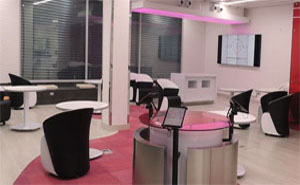 |
Banca Kristal - "Barbie Bank" |
In support of its mission to be the forward-looking national bank, BCR recently announced the start of Banca Kristal. Banca Kristal is to be a bank focused on providing services for women (note the change in terms from Banco to Banca, i.e., masculine to feminine - where are the sexist police when you need them?).
 Even the decor of the new bank is in tones of pink (see photo left), raising eyes and some objections from more modernist Ticas that BCR management needs to come into the 21st century, stop the stereotyping and rethink the idea. Critics and pundits quickly offered a new name for Banca Kristal - Barbie Bank.
Even the decor of the new bank is in tones of pink (see photo left), raising eyes and some objections from more modernist Ticas that BCR management needs to come into the 21st century, stop the stereotyping and rethink the idea. Critics and pundits quickly offered a new name for Banca Kristal - Barbie Bank.
 The pundits didn't stop there, they composed a photo of a questionable customer standing in line at a Barbie Bank branch. Closer examination revealed that the Photoshopped picture (right) was none other that San José mayor (the real guy is in photo at left) and former unsuccessful presidential candidate Johnny Araya. I suspect the authors of the photo were the same dudes that worked up the photo of sharks in the basement in the article above concerning City Mall. (Oh, but the boots are so "you", Johnny).
The pundits didn't stop there, they composed a photo of a questionable customer standing in line at a Barbie Bank branch. Closer examination revealed that the Photoshopped picture (right) was none other that San José mayor (the real guy is in photo at left) and former unsuccessful presidential candidate Johnny Araya. I suspect the authors of the photo were the same dudes that worked up the photo of sharks in the basement in the article above concerning City Mall. (Oh, but the boots are so "you", Johnny).
My guess is that Banca Kristal will eventually move down the road to historic obscurity and take it's proper place in the Museo de Particularmente Malas Ideas (Museum of Particularly Bad Ideas) right along side the Edsel, the New Coke and Gallo Pinto in a can. Nice strategy amigos, but bad execution.
Quepos Quickies
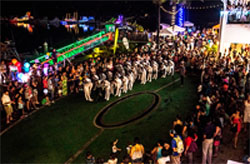 |
Marina on Boat Parade Night |
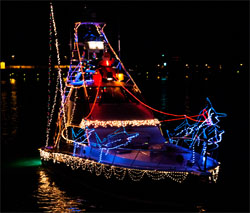 |
One Boat Showing Off Its Lights |
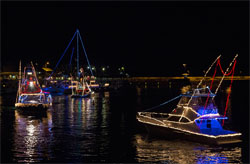 |
The Boat Parade Forms |
Boat Parade. Early December saw the second annual Quepos boat parade, called Bright Lights, sponsored by Marina Pez Vela where the event was held. The boat facility was conceived and partially built during the last worldwide economic boom in the early 2000's but didn't open until 2010, right in the middle of the recession crunch and one of the worst rainy seasons in years. So developmental progress was at first quite slow.
In the last two or three years however, the marina has come of age. The Chronicles reported in December2014 that the number of occupied boat slips had increased significantly and many of the buildings were either completed or nearing completion and that shops and offices were now beginning to fill out the space available.
As of this writing, four restaurants of different formats have also opened doors and a fifth one is opening shortly. All four have been reviewed by our ROMEO group (Runaway Grill, "Z", Gabriella's and Mercato di Porto) and received the ROMEO Club seal of approval (for food if not always for price).
On boat parade night GG was surprised to see the large crowd that was moving slowly towards the marina when he walked there from his apartment in downtown Quepos. Later he estimated that those standing in front of the main buildings, and sitting in the bleachers and the restaurants numbered on the order of 1,500 to 2,000 onlookers, a pretty sizeable turnout in a town of only 7,000 to 10,000 people.
Some of the attendees pampered themselves by hanging out and having dinner in one of the four restaurants mentioned above. Others made do with libations from several temporary bars that had been set up by the restaurants in the dock area. Warm, balmy breezes and a band playing old favorites added to a very pleasant evening.
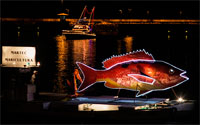 The boat parade was supposed to start at 7 PM but Tico time prevailed and it had not begun by 7:20 when GG had to leave for a previous commitment. So GG didn't get to see the parade but did have a good gander at the boats. My favorite was the little fishing boat with the big fish outlined in bright lights, an entry by our local fish processing company, Martec.
The boat parade was supposed to start at 7 PM but Tico time prevailed and it had not begun by 7:20 when GG had to leave for a previous commitment. So GG didn't get to see the parade but did have a good gander at the boats. My favorite was the little fishing boat with the big fish outlined in bright lights, an entry by our local fish processing company, Martec.
It's safe to say that Bright Lights is now a new tradition in Quepos and can only get better each year.
Progress at Plaza Bolivar. A couple of months ago the Chronicles reported on a new public improvement project (dare I call it beautification) in downtown Quepos named Plaza Bolivar.
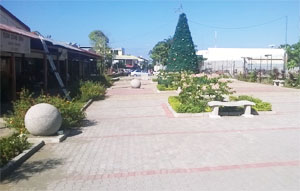 Since that time the area has been extended a little more to the west with flower beds and shrubs also being added. GG hopes the gent who takes care of the public garden areas down at the Malecón will be employed at the Plaza to water and tend those new plants because we're heading into the hottest part of the year and they are in the direct sun. Also, the tiled-in plaza now sports at least two Diquis Spheres, those amazing stone artifacts from times long past that were formed by indigenous peoples here long before the Spanish arrived; the purpose of which, and even how they were made, are not entirely clear.
Since that time the area has been extended a little more to the west with flower beds and shrubs also being added. GG hopes the gent who takes care of the public garden areas down at the Malecón will be employed at the Plaza to water and tend those new plants because we're heading into the hottest part of the year and they are in the direct sun. Also, the tiled-in plaza now sports at least two Diquis Spheres, those amazing stone artifacts from times long past that were formed by indigenous peoples here long before the Spanish arrived; the purpose of which, and even how they were made, are not entirely clear.
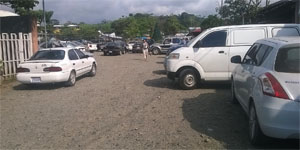 |
"Pirata Town" - What's Left of It - Note Xmas Tree at Plaza Bolivar in Background |
The Plaza on the day I took the picture above also sported a large Christmas tree in its center. I have to admit that the whole thing is definitely an improvement in the look of our downtown. I'm not sure our pirata taxi boys (perdoname amigos, nosotros porteadores) would agree as the Plaza now takes up about three quarters of the space they had been using as a gathering space for their vehicles (GG calls it "Pirata Town") and for soliciting potential fares from downtowners . But these clever dudes will surely adjust and find new ways to do business (more on their available options will be revealed in this edition below).
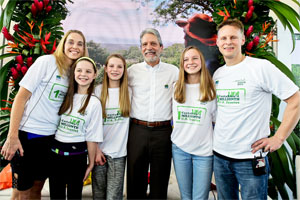 |
The Kratchovils and Minister Ventura |
Millionth American Visitor Surfs. A recent press report made note of the fact that in mid-December, the total number of American (read U.S.) visitors in Costa Rica this year to date exceeded one million, a new record. The Minister of Tourism, Mauricio Ventura, met the designated tourist family at the airport in San José to commemorate that honor, a family by the name of Kratchovil them.
The 1,000,000 figure represents about 40% of total international arrivals in Costa Rica. To give you an idea of how important that can be for a little country like Costa Rica, that number scaled to the population of the U.S. would equate to about 183 million international arrivals a year in the U.S. whereas the real total of arrivals there is closer to 75 million, not a small number in itself.
I made a passing comment to a friend here (we call him Jungle Jessie) who teaches surfing at Manuel Antonio beach about the millionth tourist and he surprised me by saying "Yes, I know, I was teaching them surfing yesterday at the beach". Dude, now that's getting right into the Costa Rica thing.
¡Pura Vida!
Rumble Talk
(Shaky Happenings On or About the Pacific Rim)
There's never a dull moment living on the Pacific Rim or anywhere on earth's volatile crust for that matter.
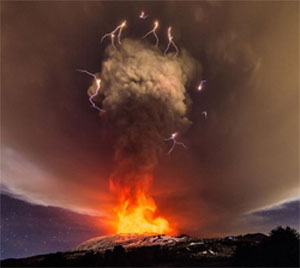 |
Mount Etna Erupting on Dec 3 |
Half way around the world from Costa Rica, in Sicily, the famous Mount Etna had a major eruption on December 3.
The photo of it to the right is made even more dramatic because those little squiggles around the gas cloud are actually lightening discharges. Oh Dio mio!
NASA announced that the Mount Etna eruption sent fountains of lava into the air and jets of hot material as high as three kilometers above the summit. Ash from the eruption was reported to have fallen in nearby villages including Messina, that World War II battleground that General Patton won. At least one airport was closed for awhile.
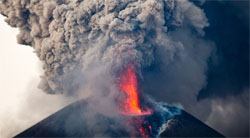 |
Mount Momotombo Erupting |
The day before Mt. Etna blew its top, on December 2, Mount Momotombo, located just above the north end of Lake Nicaragua in that country exploded for the first time in over 100 years, almost 110 to be more precise.
Few people live in close proximity to Mount Momotombo but back in the early 1600's, during the Spanish occupation, there was a busy city and trading center there known as León. Because of extensive volcanic and seismic activity in 1605, the town was relocated some 50 kilometers (30 miles) west of the volcano. I bet that last month the citizens of León were glad they had moved.
In a separate news report, some scientists have been studying The Big One (7.6R) that hit Sámara in the Nicoya peninsula on September 5, 2012 and have come to the conclusion that it was related to a 7.3R quake in El Salvador nine days earlier. Why not amigos, there's one big Pacific Rim out there running all the way down the Pacific Coast and if one part slips, wouldn't it build pressure on another part to do the same? But then I'm not a seismologist amigos, just a poor engineer and one with limited expertise in the principles of physics (see article on Morphology of a Golden Gringo below for confirmation on that).
¡Solo Bueno!
¿Que Es Eso? Department (What is This?)
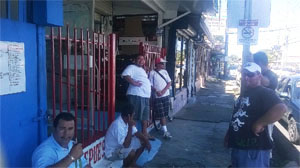 I took the photo of this scene across the street from the Quepos football field in front of Restaurant Piscis.
I took the photo of this scene across the street from the Quepos football field in front of Restaurant Piscis.
Is this just a bunch of unemployed dudes hanging around in the afternoon? Looks to me like they want to sell something. And what about that white board with the scribbling on it - what's that all about?
Answer in the What's-in-a-Word section below.
Morphology of a Golden Gringo
(Nostalgia Is Not What it Used To Be)
The beginning of the new year is a time for reflection and one's thoughts often run nostalgic. GG hopes you'll forgive him for this article; it's a shameless journey into narcissism and self-aggrandizement brought on by the time of the year and provoked by an old friend's thoughtfulness.
Here's a picture by picture commentary on this nostalgic journey:
.jpg) |
(#1) LTI Freshman Dorm 1961 |
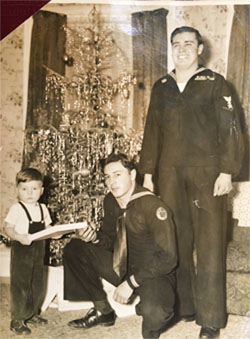 |
(#2) GG With Bro's Richard (kneeling) and Eddie (1945) |
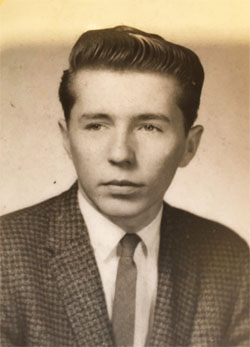 |
(#3) High School
Graduation Picture (1961) |
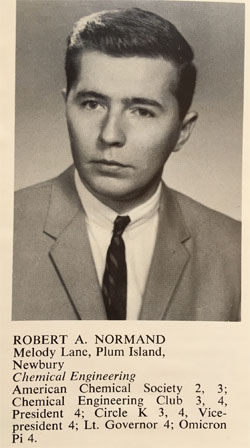 |
(#4) From 1965 LTI Yearbook |
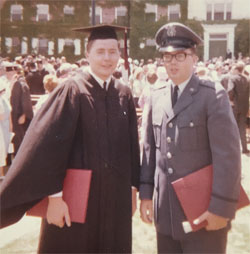 |
(#5) LTI Graduation - 1965 |
It all started when a fraternity brother from my undergraduate college days (1961-65) sent me a picture (#1) from the freshman year at LTI (Lowell Technological Institute - now the University of Massachusetts at Lowell). The picture is of GG (center) around 1961 in a dorm room with two other freshman friends. The dude to the left in picture #1 (Joe N.) was an electrical engineering major and one of my roommates. The dude to the right I believe was in chemistry; I lost track of him after graduation. The golf clubs shown were his (I could never afford that kind of luxury in those years).
That picture sent from a fraternity brother brought on the nostalgia and got me thinking about all the good times in the past. The first thing I did was ask my daughter Jenny to send me a few old pictures. Jenny has acted as the family historian for many years and has developed quite an archive of pictures. All of those shown here come from her collection except #1, which is from the fraternity brother. In the end, I had to put aside a number of pictures to avoid the article running too long.
#2 I was born in 1943, the third son and sixth child of a truck driver and shoe factory worker. I believe the picture left shows me and my brothers when I was 2 years old. I put it at Christmas time 1945, not only because of the tree but because both my brothers, still in uniform, served in the Navy in World War II and didn't return home until December of that year (the war in the Pacific ended in August 15, 1945). Both brothers are now dead, Richard of cirrhosis of the liver in his late 50's and Eddie of early-onset Alzheimer's, also in his late 50's. My bro's had (approximately) six kids between them and my three sisters added another thirteen kids to that list.
#3 Graduation picture from Immaculate Conception High School, Newburyport, Mass. in 1961. C'mon guys, give me a break, coiffures like that for men were in and Elvis was shaking his torso big time in 1961. Me too.
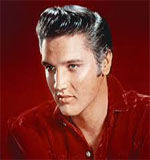 As a small, parochial high school, there were only 43 in my graduating class. There were a couple of girlfriends, both in my class, but neither resulted in a long term commitment. My personal performance in high school was mediocre (and often troublesome as I thought myself a rebel without a cause) until the junior and senior years. In the last two years I managed to accumulate enough "B" grades to allow me to apply to area colleges.
As a small, parochial high school, there were only 43 in my graduating class. There were a couple of girlfriends, both in my class, but neither resulted in a long term commitment. My personal performance in high school was mediocre (and often troublesome as I thought myself a rebel without a cause) until the junior and senior years. In the last two years I managed to accumulate enough "B" grades to allow me to apply to area colleges.
I applied to Boston College, Boston University, Northeastern University and Lowell Tech and, surprisingly, got accepted to all of them. Money, however, dictated Lowell Tech would be the choice as it was the only doable financial alternative for me. LTI was a state supported university - with $200 per semester tuition at that time (it's now about $3,000 per semester). Even then I had to work in an A&P Thursday nights, Friday nights and all day Saturday (12 hours) to make ends meet. I also worked in another A&P at home full time in the summer for the first two years, saving what I could for the school year. I made the highest part-time rate A&P had to offer at that time ($2.35 per hour).
#4 GG matriculated to LTI in September of 1961. In those days at LTI, freshmen were required to live in the dormitories where an adult proctor lived full time. Ours was a sergeant in the Air Force who was assigned to the ROTC contingent who, with his wife and child lived in an apartment on the first floor of my dorm. The room I shared with two other students was only two doors down the hall from the proctor on the same floor (did they know something about me and wanted to keep me close?)
Joe N., one of my roommates, came from western Massachusetts and was much smarter than I was but studying was not high on his priority list at that time and, when we moved to an apartment off campus in the first semester sophomore year, he flunked out as did our other roommate, a close friend of Joe's. I hung on by the skinney-skin-skin of my teeth and had to go to summer school to re-do Calculus II and Physics II (I never did come to like physics). I got B's on the retake which got me off the Dean's sh** list and avoided untimely discharge from the university.
#4 But, in the second semester sophomore year, after watching my roomies flunk out, I came to a couple of conclusions about myself. First, I realized that I had come to actually like the learning process (physics excepted) and secondly, if I tried harder, I might actually succeed. I started getting serious. The second semester went better - no summer courses would be required that year.
At the end of my sophomore year I also applied to a fraternity at the suggestion of my roommate, who had entered the year before; Οπ or Omicron Pi. Also, Οπ had a good academic reputation
and I thought that wouldn't hurt my new found desire to learn. So I joined and suffered the slings and arrows of outrageous hazing during hell week at the beginning of my junior year. (The yearbook posting has one thing wrong - I was in Οπ in both
junior and senior years - I must have fed the system the wrong info back then and didn't catch it before they printed the yearbook)
That yearbook would be put to interesting use during an experience some ten years later when we were living in Brussels. One Sunday morning my wife and I and our oldest daughter had gone to the Brussels national cathedral to listen to the Dutch National Boys Choir and a 20 piece orchestra perform a Mozart Mass. We all stood on the floor of the huge cathedral and I casually noticed a man in the crowd some 50 feet away that I was sure I knew, but I didn't know why nor could I remember his name at first glance. Finally, after an hour of looking at him, I realized that it was Martin Lydon, the man who had been president of Lowell Tech and who had handed me the degree I'm holding in the picture. We invited him and his wife to dinner at our house and they accepted.
They were very personable and we had a jolly old time talking about the old days and reminiscing through the yearbook. During the intervening years since my graduation and our meeting in Brussels, Lowell Tech became fully integrated into the Massachusetts Sate University system. At the same time, LTI was merged with Lowell State College, a liberal arts college also in the state system and located a stone's throw across the Merrimac River from LTI. The resulting institution became known as the University of Massachusetts at Lowell. I asked President Lydon why he decided to do that and was surprised to learn that he had been against the merger all along, preferring to retain the technical nature of the core of the university, but he was overruled by the state education and political powers.
#5 In the second semester of my junior year I hit the other dean's list, the good one, and stayed on it for two years and ended my undergraduate career with a good enough cumulative point average to apply for and get a graduate school fellowship in Chemical Engineering at Villanova University, near Philadelphia. The picture shown above was graduation day at LTI. The little red folders under our arms are our degrees, both B. S.'s in Chemical Engineering. The gent posing along with me was one of my roommates in the junior and senior years and also a fraternity brother. Fraser H. opted to wear his uniform (ROTC guys could elect to wear their uniforms to graduation ceremonies). Fraser went on to be a colonel in the air force, serve in Viet Nam and return to the U.S. to raise a family. Sadly, he died a few years ago.
Commencement speakers on my graduation day were newly elected (1962) Senator Ted Kennedy (this was before Chappaquiddick; I think he was sober on my graduation day) and Cardinal Richard Cushing, the head of the Boston Archdiocese and the priest that buried John F. Kennedy after the assassination. I forget what Ted had to say. Cushing alluded to the fact that he had never gotten any honorary degrees until he became a cardinal, but now had a "bunch of them". Yeah dude, but this is the only one that came from Lowell Tech, amigo.
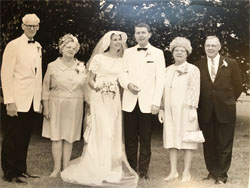 |
(#6) June 24, 1967 With Parents |
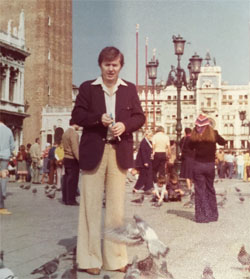 |
(#7) GG in 1971 (methinks) in Amsterdam (or Venice, Italy) |
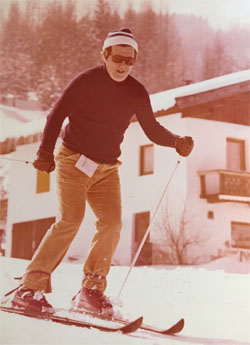 |
| (#8) Europe Days Skiing in Austria |
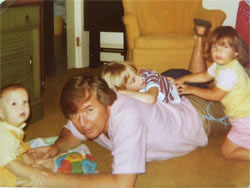 |
| (#9) GG With the 3 Munchkins (ca. 1978),
Jeff-1, Jenny-6, Cindy-2 |
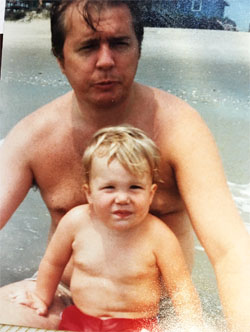 |
(#10) GG With Jeffers at the Beach (Rehoboth?), Around 1978 |
#6 As the old adage says: "If you want to hear God laugh, tell him your plans". One of those coincidental things that life always brings your way happened in my junior year when I pulled the posting of a summer job off the Chem Engineering Department bulletin board. It was a lab technician position for a special project at a chemical company near Wilmington, Delaware and it paid $600 per month, more money than I had ever made in my life. So my A&P career was over and I was off to Delaware on a new adventure. The first day there I met the sister of a lab chemist and a new phase of my life began. She was a sophomore at the University of Delaware. We would be married some three years later after she had completed her B. S. and I finished my Masters.
In June of 1967, within the space of three weeks, I would take my oral exams, present my thesis (the future wife helped with typing and presentation), we were married in Wilmington, Delaware, spent a week in Bermuda on honeymoon and moved to southeastern Ohio to start my first position as a process engineer ($10,500 per year - again more money than I had ever made and a good rate for a starting Ch.E. in 1967). The wife worked also, making $5,500 as a second grade teacher in the pubic school system. With that kind of affluence in hand (yuk, yuk), life was easy and good; our modern, two bedroom apartment with pool overlooking the Ohio river cost only $200 per month back then. And we had no child expenses the first five years.
#7 Children came slowly, something about a problem in conceiving that would be solved later (son Jeff is the proof). We lived a fairly care-free life in the five years following graduation and in 1971 we decided to make a trip to Europe, taking advantage of and sponging on two different relatives of my wife who were located in Amsterdam and Naples, Italy. We made six stops: Amsterdam, Zurich, Rome, Naples, Paris and Lisbon (check out those cool bell-bottoms on the GG dude in pic #7). Coming home from Lisbon on the plane I remarked to the wife: "Well that was wonderful, but I doubt we'll be able to come back soon". Uh-huh.
The next year, the emphasis in the strategic planning department that I was working in at my company (after two years in the plant I was transferred into that group in the headquarters) shifted to Europe from the U.S. I began traveling there on business and made 13 trips, from one to six weeks in duration, over a 24 month period, using Amsterdam as a base of operation.
On my first business trip I was in Amsterdam only two days when I got a call from the wife that a two-week old baby, for which we had applied sometime before, was available for adoption. I returned on the first plane the next morning carrying only a shaving kit, wearing disheveled clothes and a two-day beard (today I would have easily been shunted aside as a terrorist). We picked up our first child (whom we christened Jennifer Kristen Normand - my Jenners) and I returned to Amsterdam four days later. I had gone over the Atlantic pond three times in one week.
#8 Four years later we found ourselves living in Brussels and we lived there for two and a half years. We were very fortunate during those years to be able to see much of Europe all the way from England to Italy and from Germany to Spain. We even found time to vacation twice in Austria skiing (photo) and also spend two weeks in Tunisia getting a taste of the arab world, including one day riding a camel on the edge of the Sahara.
Back in Brussels one morning, as I walked into the office, my secretary (that's what we called our assistants in 1976) said I had a call from Ohio. It turned out to be the same adoption service we used for Jenny and they said they had another baby girl - "Do you want her?" Surprised, I could only say ya...ya...yes! In the course of the conversation I asked about the baby's background, knowing how the adoption service had emphasized trying to match babies background with their new parents (my wife was of German-Irish extraction, while I was of 100% Canadian french derivation). "Italian-Hungarian" was the response. "Perfect!" says I.
#9
This time the wife and I deposited Jenny with some trusted friends and made a hurried trip back to Ohio together, picked up our new baby, had another christening and party and were back on the road as three passengers in a matter of a few days. The family grew by one and we christened our new daughter Cynthia Marie Normand - my Cinners. The company I worked for was very thoughtful and generous as they routed us home through Washington, DC so we could pick up a passport for Cindy without delay. Her first passport picture showed her as a babe on a nun's lap.
We moved back to Marietta, Ohio from Brussels in 1977 but we weren't there three months when the wife announced she was pregnant. I always blamed the lack of heating in our new bedroom on that but it was probably the doctor's effort with my wife before we moved to Europe - anyway he claimed it was his good doctoring. In November of that year the last of the munchkins was born and we christened him Jeffrey Robert Normand - my Jeffers. For the next five years the family prospered and the kids grew, everyone staying healthy.
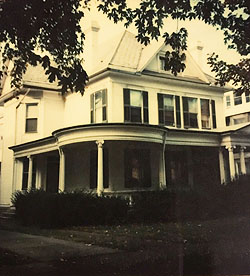 |
(#11) 4th Street, Marietta, OH |
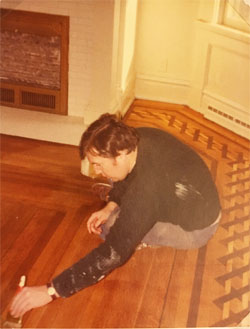 |
#12 GG Resurfacing Floor |
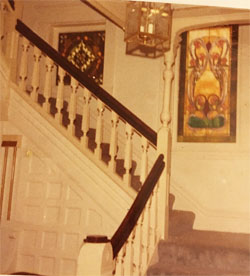 |
#13 Stained Glass Windows |
#11 These were heady times. The family was now at full strength. On our return move to the United States we were lucky to find that one of the oldest houses in downtown Marietta was for sale, a Queen Anne style home with four bedrooms, perfect for the five of us. $60,000 bought it (♫ those were the days my friend, I thought they'd never end...♫).
#12
This "fixer-upper", my favorite house of all time, had been in one family since its construction 85 years earlier in 1892. It was built by a man who started the first, and now oldest, bank in Marietta. He employed local German craftsmen and artisans. It would only be ours for five years before we had to move on to another job in another part of the U.S. (Allentown, PA), but it was a special five years.
The house boasted 3,300 square feet of floor space, five fire places, nine foot ceilings on the two main floors, a porch that sported 11 fluted wooden columns with corinthian capitals and a wood balustrade that wrapped around two sides of the house. There was beveled glass bordering the large oak entrance door, hardwood floors throughout including three different designs of inlaid mahogany borders and incredible stained glass windows on the stairway to the second floor (#13).
Also, the ceilings on the main floors offered molded plaster, "cake piping with escutcheons" the interior decorator called them. We spent the next three years renovating, renewing and updating that special house. The lady who had owned it previously, the granddaughter of the banker mentioned above, had mostly taken good care of the building but had no appreciation for the features or simply had lost interest. She had covered incredibly beautiful hardwood floors with carpeting and, in some places, linoleum. We spent many hours pulling up carpet and linoleum, scraping up adhesive, then carefully sanding the floors and re-varnishing them (#12).
Life was good, it was really good, but nothing ever stays the same forever. In the early 1980's it became apparent that the company where I had worked for over 14 years and I needed to part ways. New work was found with a major chemical company based in Allentown, PA and we had to pick up and move once more.
_ _ _
I feel that it would be a good idea to stop this narrative here before the reader gets worn out. Twenty seven more years (2008) would pass before GG would find himself in Costa Rica sending periodic reports of life here back to family and friends. That early writing spree turned into the Golden Gringo Chronicles.
I hadn't intended to construct an autobiography here but the above is basically an outline of one, at least for the early years. We moved on as a family to Allentown, PA and GG would spend the next 17 years there. There would be good times, the family easily integrating into our new community and church and starting our own computer-related business that ran for ten years.
The kids would spend their formative years in Allentown, reach their teenage years and some would go to college. The "kids" (as of this writing, aged 43, 39 and 38) today are all gainfully employed in disparate industries (information technology, food service management and health care).
 |
The Golden Gringo Today With Some Costa Rican Friends |
There would also be bad years with a recession (1990) and reversal in business leading to bankruptcies, both personal and business as well as various pressures leading to divorce. The '90's would not be nearly as kind to us as the '70's and '80's were. But eventually we would all make new lives and do well.
GG discovered along the way that he liked to write and wrote three books as well as starting the monthly Chronicles newsletter. Eventually he would see that he had been lucky ("golden") to have settled in Costa Rica in his "golden" years, thereby morphing into the Golden Gringo.
So, as I see it, it takes all kinds of experiences to make a life. As my mom used to say: "If you don't have good and bad times, you haven't had a full life". Mom died on New Year's eve, December 31, 1981 at the age of 76, following her husband who died in October 1976 at the age of 77.
Mom was wiser than I gave her credit for at the time. Nostalgia just is not what it used to be, mom.
P.S. Thanks to Kyle P. for the initial picture that started off this exercise in nostalgia.
(OK, let the snarkey comments on the above begin; email gg@goldengringo.com).
¡Solo Bueno!
TOP
Supermarket Soup
(What's in a Grocery Store Name?)
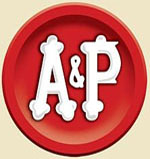 GG noted in the morphology article above that his first job was as a clerk in an A&P (officially, The Great Atlantic & Pacific Tea Company). I had seen that company go through changing times when I worked there and watched its subsequent decline from being the dominant retailer in the world in the 1950's (Walmart wasn't even founded until 1962). A&P celebrated it's 100th year in business in 1959 and was the largest retailer in the U.S. until 1965, bigger than Sears, Roebuck and second in revenues only to General Motors. GG was disappointed, but not surprised, to learn that A&P Supermarkets disappeared into bankruptcy in 2015 after 156 years in business, having been founded in 1859 by a certain gentleman named George Gilman as Gilman & Company. It was later bought out by the wealthy family headed by Huntington Hartford until its demise.
GG noted in the morphology article above that his first job was as a clerk in an A&P (officially, The Great Atlantic & Pacific Tea Company). I had seen that company go through changing times when I worked there and watched its subsequent decline from being the dominant retailer in the world in the 1950's (Walmart wasn't even founded until 1962). A&P celebrated it's 100th year in business in 1959 and was the largest retailer in the U.S. until 1965, bigger than Sears, Roebuck and second in revenues only to General Motors. GG was disappointed, but not surprised, to learn that A&P Supermarkets disappeared into bankruptcy in 2015 after 156 years in business, having been founded in 1859 by a certain gentleman named George Gilman as Gilman & Company. It was later bought out by the wealthy family headed by Huntington Hartford until its demise.
 |
Old A&P Neighborhood Market |
It was apparent in the 1950's that the type of supermarket that would succeed in the future was going to be larger and larger floor-wise and would carry many more items than could be fitted into a neighborhood grocery store. But A&P was more or less stuck with literally thousands of small store-front grocery stores like the one shown in the photo to the right. At one point A&P had over 16,000 stores in the U.S., many of which had to be closed in lieu of trying to replace them with larger ones opening in the suburbs. But the shift to larger, suburban stores required a lot of capital and it also changed their customer base which resulted in lost loyalty. The shift to convenient stores at gas stations (7/11) also hastened the decline of A&P's smaller stores.
When GG first came to Quepos he felt like he was back in the 1950's. The neighborhood store is still alive and well here and there are four of them within three blocks of my apartment. It took some getting used to as they may go by different names such pulpería, mini-super, abastecedor or supermercado. But anymore the differences between them are slowly disappearing.
 |
| Mini-Super Chomay |
The photo shown is a small corner grocery store one block from my apartment. It used to be a pulpería but it changed ownership a year or so ago and now calls itself a "Mini-Super Chomay " (I presume "Chomay" is the family name) Despite this store being the closest to me I often choose to go to the opposite side of this block to a larger market with more choices ("Super Jordix"). The staff at Jordix (Alejandro, Luis, Maria José, Rudy, Angélica, Andres...) are now my amigos.
A pulpería is usually the smallest of the markets and is unlikely to offer fresh meat or produce (maybe a limited amount of fruit). In the old days, a pulpería was a place where the customer might also obtain credit, but that option is fast disappearing. It reminds me again of the 1950's as I remember my parents doing business with a small, well-run, Greek-owned market where they ran up a bill and cleared it every couple of weeks, usually on payday. "Hey, Mr. Papadopoulos, how ya doin'?"
The other type of market mentioned above, the "abastecedor", is a term that literally translated means "supplier". At an abastecedor you may often find non-food items offered as well. The term is also used by appliance and other types of stores that offer no food.
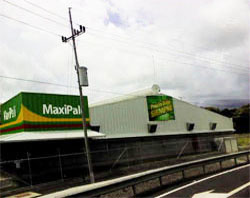 |
| MaxiPali, Our Largest Supermarket |
As mentioned in earlier articles three of the larger neighborhood markets here have recently expanded. And, about two years ago, the largest market in the immediate area opened up on the outskirts of Quepos, by the name of MaxiPali (photo). It, along with an older Pali in town are both Walmart properties and the closest thing to what a gringo would recognize as a "Super" market. Of course in the central valley, where some 40% of all Costa Ricans live in a relatively small area, there are very large supermarkets including several Walmarts.
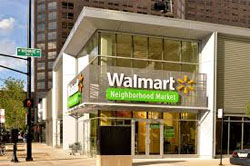 |
Walmart Neighborhood Market |
Will the trend continue and Costa Rican neighborhood markets go the same way as the U.S. and the A&P? GG noticed something quite interesting during his last visit to the U.S. in September, the emergence of chain "Neighborhood Markets", chiefly led by Walmart.
I left the U.S. only seven years ago but I don't remember the presence of this kind of market in Sarasota at that time, yet now there are several of them. They range in size from a corner market like the one in the photo to the right to a considerably larger market. The key strategy seems to be to position these markets in older commercial centers and small strip malls, so that they are indeed a neighborhood market. At the same time of course, Walmart, over the last two decades, has made a major entrance into food stores of all kinds, including giant-sized hypermarkets.
It will be interesting to see if this new neighborhood strategy by Walmart will work, as it's virtually 180 degrees from the trend in food marketing that's occurred in the last 50 years. Maybe the neighborhood markets in Costa Rica won't have to follow the old trend either? GG continues to watch these changes with interest (once a grocery clerk, always a grocery clerk).
I also have a personal, old-world attraction to dealing with smaller local markets and the personal relationships they offer the customer. I can tell you when certain clerks and managers at some of my local markets play futbol at our neighborhood indoor arena or which lady clerk just got engaged (I'm more discreet about pregnancies).
There's something to be said for that kind of charm - nostalgia can be what it used to be, amigos.
¡Pura Vida!
TOP
Revisiting Las Playas de Jakób
(And A Coastal Advance in Thespianism)
The town is well known by tourists as Jacó and often mispronounced by visitors. It's Hah-ko, not Hah-co or Jack-oh. The place was originally known as Las Playas de Jakób and named after a gentleman who actually bought much of the area in the early 1900's. The name eventually evolved into simply Jacó.
The town of Jacó is the capitol of the Canton of Garabito just as Quepos is the capitol of the Canton of Quepos (it used to be the canton of Aguirre). Garabito is smaller than Quepos by some 8,000 people (about 22,000 versus nearly 30,000) and is only about 60% of the land area of Quepos at 316 square kilometers versus 544 (123 square miles versus 213). But the place looks bigger. As a friend suggested that's because it's more concentrated, particularly along the main street that borders the beach.
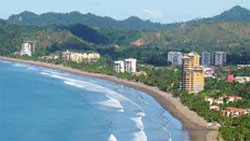 Jacó is approximately 75 kilometers (45 miles) up the coastal road from Quepos and with the good quality of the roads these days it can be reached in little more than an hour by car. It's also only 117 kilometers (70 miles) from downtown San José and, with the new autopista and no traffic impediments can be reached from the central valley in an hour and a half or less. These days that makes it an easy day trip or weekend jaunt from the central valley where 40% of Costa Ricans live, as it also does for Quepos/Manual Antonio for that matter. Jacó has always been popular with tourists, particularly with the younger crowd for its long beach, good surfing and extra-curricular activities (use your imagination amigos).
Jacó is approximately 75 kilometers (45 miles) up the coastal road from Quepos and with the good quality of the roads these days it can be reached in little more than an hour by car. It's also only 117 kilometers (70 miles) from downtown San José and, with the new autopista and no traffic impediments can be reached from the central valley in an hour and a half or less. These days that makes it an easy day trip or weekend jaunt from the central valley where 40% of Costa Ricans live, as it also does for Quepos/Manual Antonio for that matter. Jacó has always been popular with tourists, particularly with the younger crowd for its long beach, good surfing and extra-curricular activities (use your imagination amigos).
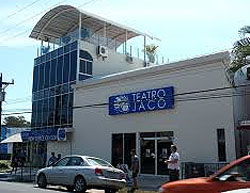 The Chronicles first made note of the opening of a performing arts center in Jacó in the November 2011 edition. Recently, a couple of ROMEOs revisited Jacó to take in a play at the center, our first visit to the new theater. The theater is located on the north end of the main drag of Jacó Beach (Avenida Pastor Diaz) across the street from the Mas X Menos supermarket. (OK, how come they get street names in Jacó and we don't in Quepos?)
The Chronicles first made note of the opening of a performing arts center in Jacó in the November 2011 edition. Recently, a couple of ROMEOs revisited Jacó to take in a play at the center, our first visit to the new theater. The theater is located on the north end of the main drag of Jacó Beach (Avenida Pastor Diaz) across the street from the Mas X Menos supermarket. (OK, how come they get street names in Jacó and we don't in Quepos?)
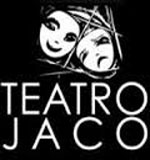 Teatro Jacó is an intimate playhouse with seating for about 60-70 on the main floor and another 50 or so in the balcony. For this performance it was about three-quarters full so it was quite comfortable. We sat in the second row back (it always pays to get there early when seating is unassigned) and we were literally sitting about ten feet from the edge of the stage and sometimes nearly as close to the actors.
Teatro Jacó is an intimate playhouse with seating for about 60-70 on the main floor and another 50 or so in the balcony. For this performance it was about three-quarters full so it was quite comfortable. We sat in the second row back (it always pays to get there early when seating is unassigned) and we were literally sitting about ten feet from the edge of the stage and sometimes nearly as close to the actors.
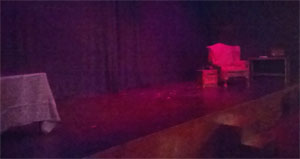 |
Stage Set for Opening Scene |
The play we went to see is called "Bill W. and Dr. Bob" and is about the two men, a New York stockbroker and medical doctor (urologist), both self-admitted and desperate alcoholics who came together and founded Alcoholics Anonymous in 1935, and virtually changed the world for a lot of people.
Knowing something of the story, I was impressed with both the writing and the acting of the story version as portrayed. The strengths, frailties and character of the principal subjects were well thought out and quite true to historical accounts. Of course, we thespian critics riding home in the car made judicious and weighty pronouncements about certain of the cast being more seasoned actors than others and how certain stage positions might have been changed to produce a more specific, enhanced result, but the bottom line was that the performance was dramatic and engrossing.
Teatro Jacó is a welcome addition to our coastal communities and we look forward to seeing many performances there. (To contact the theater: 506 2609 9812 or http://www.teatrojaco.com/)
Break a leg, amigos!
¡Solo Bueno!
TOP
Travel Quote of the Month
| “Tourists don’t know where they’ve been, travelers don’t know where they’re going.” – Paul Theroux |
What's-in-a-Word
Answer to Que Es Eso?
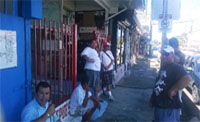 Those guys in the photo are porteadores (unlicensed taxi drivers, also known as piratas or pirate taxis). Apparently a number of them have grouped together in an informal professional organization and based themselves in that location. Probably finding another base was motivated by the city taking over their old gathering place in what is now Plaza Bolivar (see Quepos Quickies section in Broken News above). When I first noticed them, they had named their home location "Base Lagarto" or Lizard Base. Later they changed the name of their gathering place to Base Tárcoles. Tárcoles is the name of a town just south of us on the Savegre river that has a lot of crocodiles, as do most river mouths here. So evidently the boys have graduated from being lizards to becoming crocodiles. Grrrr.
Those guys in the photo are porteadores (unlicensed taxi drivers, also known as piratas or pirate taxis). Apparently a number of them have grouped together in an informal professional organization and based themselves in that location. Probably finding another base was motivated by the city taking over their old gathering place in what is now Plaza Bolivar (see Quepos Quickies section in Broken News above). When I first noticed them, they had named their home location "Base Lagarto" or Lizard Base. Later they changed the name of their gathering place to Base Tárcoles. Tárcoles is the name of a town just south of us on the Savegre river that has a lot of crocodiles, as do most river mouths here. So evidently the boys have graduated from being lizards to becoming crocodiles. Grrrr.
The white board is a listing of cabs available in the order of first come, first serve, an attempt at putting priorities on who gets served next (often soliciting a pirata is a free for all as to who can get to you first). At Base Tarcoles, each cab has it's own two-digit number. The highest number on the board at the time I saw it was 37.
Why is Spanish so much like English?
GG has been receiving almost daily emails from one source (a gent) that wants badly to teach me (and a few hundred others) how to improve my Spanish. This would be by way of an online program, for only $400 of course. I'm still hesitating to sign up, but I found the gent's marketing approach impressive and the following historical write-up that he recently offered interesting:
"The many similitudes (similarities) between
Spanish and English are due to Guillermo el Bastardo (William the Bastard).
Guillermo became better known for his deeds
than his illegitimate birth after 1066 AD. Since
then he's been known as Guillermo el Conquistador (William the Conqueror).
His Norman invasion of Britain in 1066 saw
French become the official language of
school and law courts. And they imposed
the language on the conquered people.
It stayed that way for the next 300 years.
As a result, to this day thousands of
words from French are an everyday part
of English.
French and Spanish are both romance
languages. So the left over French words
are a lot like Spanish words also.
There are literally thousands of words that
you'll instantly recognize in Spanish. Por ejemplo:Universidad,
Problema,
Constitución,
Instante, Aniversario..."
I'm not yet convinced to spend the $400 but he sure makes the learning process interesting.
TOP
Search the Golden Gringo Chronicles Archives for the topics that interest you
You can use our Archives to explore over 170 feature articles of the Golden Gringo Chronicles plus find Broken News items and ROMEO restaurant reviews. Enter your topic or item to search for in the Google Search Routine below and follow the links offered from the search results. Suggestion: Enter only a simple and precise keyword or two in order to narrow the number of references retrieved:
Golden Gringo Chronicles - Enter Search Here
ROMEO Corner
(Retired Old Men Eating Out)
El Hicaco, Jacó
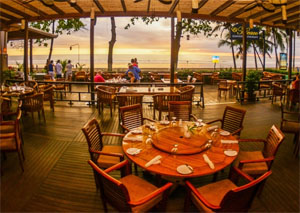 Location: Calle Hicaco, South End, One Block off Main Street (Ave. Pastor Diaz)
Location: Calle Hicaco, South End, One Block off Main Street (Ave. Pastor Diaz)
Hours: 11 AM to 11 PM Daily (Dinner after 5 PM).
Parking: Ample at the Restaurant.
Contact: Tel.: (506) 2643 3226; Email: N/A
Website: http://www.elhicaco.com/
Reviewing ROMEOS: Brian M., Bob N.
To Review Our Rating System and Procedure, go here: R.O.M.E.O. Rating System
While we were in Jacó we decided to take in this restaurant before going to the Teatro Jacó (see article above). This ROMEO Review stuff is hard work, amigos, but we're dedicated.
My first question was : "What the heck is a hicaco?" Actually, it was the second thing I asked about, the first thing I needed to learn was how to pronounce it: it's ee-kah-ko.
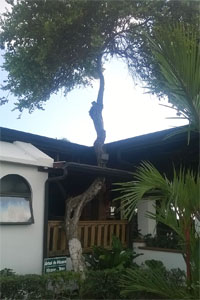 |
Hicaco Tree |
 |
Hicaco or Coco-Plum |
Then I learned from out waiter, a gent who seemed to be a senior member of the wait staff, that it's actually a tree that produces a fruit of the same name. He took me outside the restaurant to show me a hicaco tree that the restaurant has preserved, even to the extent of building the roof around it. The waiter said that particular tree is between 38 and 40 years old.
The common name for the hicaco fruit is the coco-plum and it can be red, white, blue or yellow. It grows wild in cypress swamps, low areas, tree islands, beaches, sand dunes, canals, riversides, oceanside thickets, hammocks, by lakes, ponds and in landscaping. It even grows in Florida, typically in the center of the state.
The restaurant, as you can see from the photo at the top of the article is situated right on the beach. It's a large restaurant, my estimate is it can seat over 100 people. We sat on the deck and got the full effect of the gorgeous Pacific sunset. Just below the deck on the beach was an area blocked off with torches and having straw mats on which musicians were to play, but we were early and didn't get to see and hear that. For atmosphere we have to give El Hicaco 5 sloths.
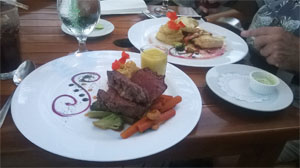 The menu had a good selection of appetizers and main courses of seafood, steaks and poultry. GG started with a small chicken sateh appetizer (fresh and tasty) and moved on to a lomito (filet) that was offered with a selection of sauces and I asked for the bernaise. What I got is shown in the photo; it wasn't a classical bernaise but a tasty sauce nonetheless. The lomito was delicious and tender. The menu had a good selection of appetizers and main courses of seafood, steaks and poultry. GG started with a small chicken sateh appetizer (fresh and tasty) and moved on to a lomito (filet) that was offered with a selection of sauces and I asked for the bernaise. What I got is shown in the photo; it wasn't a classical bernaise but a tasty sauce nonetheless. The lomito was delicious and tender.
My dining partner ordered a chicken dish he reported on favorably. One of the things we were impressed by was the presentation, quite artful and attractive, including the real flowerets on the plates (see photo).
|
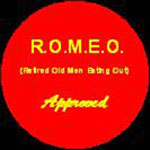 |
.jpg) 1/2 1/2 |
$$$$ |
Value Index = 113 |
Both of us are chocoholics and we both ordered a chocolate volcano dessert. The large cupcake with a warm liquid chocolate center accompanied by good vanilla ice cream was tasty but we both felt the dessert selection and execution didn't quite live up to the level of the main course menu. For food quality we give El Hicaco four and a half sloths.
With regard to service, both our waiters were friendly, helpful and courteous. The courses were a little slow in coming, especially considering only a half dozen tables in the restaurant were occupied at this early dinner hour, but it was not overwhelming. Also, the service seemed to slow down when we began to get a light sprinkle in our section which was uncovered, but that's understandable as the staff was busy trying to move some tables into the covered areas. The sprinkles never became heavy enough for us to move. We give El Hicaco four sloths for service and an overall rating of four and a half sloths for atmosphere, food quality and service.
The bill came in at about 16,000 colones (just about $30) for my partner's two courses. For my three courses of chicken sateh, filet bernaise and chocolate volcano along with a coke and a cup of coffee, my total was just over 24,000 colones or about $45. This puts El Hicaco in the top 20% of expense ratings but not in the top 10% so we give the restaurant a cost rating of $4 and a value index of 4.5/4x100=113.
El Hicaco offered us a good meal in a beautiful setting for a fair price. We can give it the ROMEO seal of approval.
Golden Gringo Chronicles Novel and E-Books Now Available!
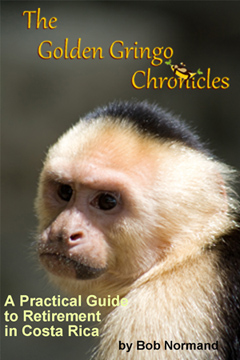 The story of the Golden Gringo Chronicles is also available as a hard copy novel of 192 pages available through Amazon and all major online retailers. ($9.95)
The story of the Golden Gringo Chronicles is also available as a hard copy novel of 192 pages available through Amazon and all major online retailers. ($9.95)
Amazon link: GGC, the Book. (Kindle Edition available)
Follow GG through the first six years of his odyssey in making the decision to retire in Costa Rica, overcoming the trials and tribulations of moving and obtaining residency there and the fun and experience of actually living in Ticoland.
Ride along with the Golden Gringo as he learns about the rich, varied culture of Costa Rica, the incredible bio diversity, the charming nature of the Costa Rican people and the ease with which a sometimes clueless ex-pat can assimilate into a small southwestern town on the Pacific coast.
Whether you are already a Costa Rican resident, someone contemplating a move here or just a traveler who enjoys different cultures, you will find the Golden Gringo Chronicles interesting, entertaining and informative about Costa Rica.
A narrative version of the Golden Gringo Chronicles is now also available as a trilogy of E-books in formats compatible with virtually all electronic platforms.
Part 1: (FREE!)
Leaving the Homeland
Part 2: ($3.99)
The Early Years
Part 3: ($3.99)
Becoming Tico, Maybe
Click on Part Number above for E-book sample downloads or click the price above right for purchase. (The best price is on Part 1; it's FREE)
Opt-In Here to Receive Your Free Copy Monthly
The Golden Gringo Chronicles is a free newsletter that is non-political, non-commercial and, hopefully, entertaining. By signing up you will receive an email each month around the first of the month giving you the links to the latest edition as well as to each individual feature and departmental section.
CLICK HERE TO SIGN-UP FOR THE
GOLDEN GRINGO CHRONICLES
or Email me at gg@goldengringo.com

The Golden Gringo
Pura Vida!
To Contact GGC World Headquarters (yuk, yuk) to make comments, suggest topics or criticize my bad jokes, just send an email to: bob@bobnormand.com.
Be pithy but kind; I'm sensitive.
Unsubscribe from Golden Gringo Chronicles
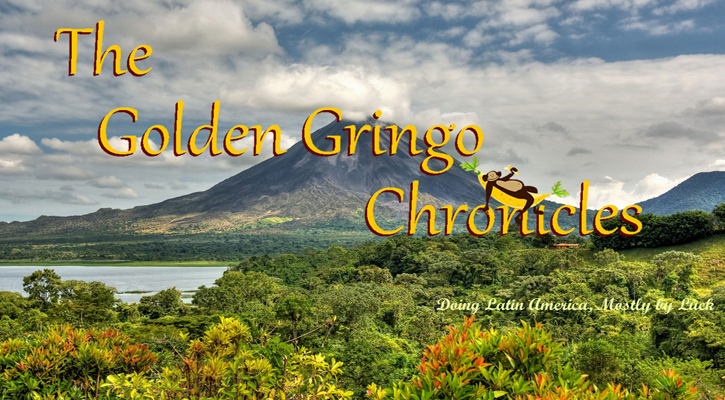


 It's been over five years since Nicaragua invaded the small island of Calero in the northeast corner of Costa Rica. Ostensibly a "dredging operation" it turned out to be a bold attempt, some would say aggression, to cut a new channel mouth for the San Juan river across Costa Rican territory. Plans were later announced that Nicaragua would build a canal across the country to compete with the Panama Canal and that it would utilize the new mouth at the San Juan as well as the river itself and Lake Nicaragua.
It's been over five years since Nicaragua invaded the small island of Calero in the northeast corner of Costa Rica. Ostensibly a "dredging operation" it turned out to be a bold attempt, some would say aggression, to cut a new channel mouth for the San Juan river across Costa Rican territory. Plans were later announced that Nicaragua would build a canal across the country to compete with the Panama Canal and that it would utilize the new mouth at the San Juan as well as the river itself and Lake Nicaragua.
 In December the problem got worse when Belize and Guatemala joined Nicaragua with a not-welcome-here policy of its own. Actually they were saying that there needs to be a regional solution to the problem before they agree, whatever that means. With Nicaragua cutting off land access from the south and Belize/Guatemala blocking exit to the north, use of El Salvador and/or Honduras becomes a moot point, at least by land routes (see map).
In December the problem got worse when Belize and Guatemala joined Nicaragua with a not-welcome-here policy of its own. Actually they were saying that there needs to be a regional solution to the problem before they agree, whatever that means. With Nicaragua cutting off land access from the south and Belize/Guatemala blocking exit to the north, use of El Salvador and/or Honduras becomes a moot point, at least by land routes (see map).
 The opening of a major mall in the Central Valley, the City Mall, was announced in the press recently with a flourish. The City Mall is actually located in Alejuela, not in San José proper. It is not unusual for a large new enterprise to have a number of physical start-up quirks to overcome and City Mall followed tradition. Here are the issues that are still being worked on at City Mall.
The opening of a major mall in the Central Valley, the City Mall, was announced in the press recently with a flourish. The City Mall is actually located in Alejuela, not in San José proper. It is not unusual for a large new enterprise to have a number of physical start-up quirks to overcome and City Mall followed tradition. Here are the issues that are still being worked on at City Mall.



 Even the decor of the new bank is in tones of pink (see photo left), raising eyes and some objections from more modernist Ticas that BCR management needs to come into the 21st century, stop the stereotyping and rethink the idea. Critics and pundits quickly offered a new name for Banca Kristal - Barbie Bank.
Even the decor of the new bank is in tones of pink (see photo left), raising eyes and some objections from more modernist Ticas that BCR management needs to come into the 21st century, stop the stereotyping and rethink the idea. Critics and pundits quickly offered a new name for Banca Kristal - Barbie Bank. The pundits didn't stop there, they composed a photo of a questionable customer standing in line at a Barbie Bank branch. Closer examination revealed that the Photoshopped picture (right) was none other that San José mayor (the real guy is in photo at left) and former unsuccessful presidential candidate Johnny Araya. I suspect the authors of the photo were the same dudes that worked up the photo of sharks in the basement in the article above concerning City Mall. (Oh, but the boots are so "you", Johnny).
The pundits didn't stop there, they composed a photo of a questionable customer standing in line at a Barbie Bank branch. Closer examination revealed that the Photoshopped picture (right) was none other that San José mayor (the real guy is in photo at left) and former unsuccessful presidential candidate Johnny Araya. I suspect the authors of the photo were the same dudes that worked up the photo of sharks in the basement in the article above concerning City Mall. (Oh, but the boots are so "you", Johnny).


 The boat parade was supposed to start at 7 PM but Tico time prevailed and it had not begun by 7:20 when GG had to leave for a previous commitment. So GG didn't get to see the parade but did have a good gander at the boats. My favorite was the little fishing boat with the big fish outlined in bright lights, an entry by our local fish processing company, Martec.
The boat parade was supposed to start at 7 PM but Tico time prevailed and it had not begun by 7:20 when GG had to leave for a previous commitment. So GG didn't get to see the parade but did have a good gander at the boats. My favorite was the little fishing boat with the big fish outlined in bright lights, an entry by our local fish processing company, Martec. Since that time the area has been extended a little more to the west with flower beds and shrubs also being added. GG hopes the gent who takes care of the public garden areas down at the
Since that time the area has been extended a little more to the west with flower beds and shrubs also being added. GG hopes the gent who takes care of the public garden areas down at the 



 I took the photo of this scene across the street from the Quepos football field in front of Restaurant Piscis.
I took the photo of this scene across the street from the Quepos football field in front of Restaurant Piscis. .jpg)




 As a small, parochial high school, there were only 43 in my graduating class. There were a couple of girlfriends, both in my class, but neither resulted in a long term commitment. My personal performance in high school was mediocre (and often troublesome as I thought myself a rebel without a cause) until the junior and senior years. In the last two years I managed to accumulate enough "B" grades to allow me to apply to area colleges.
As a small, parochial high school, there were only 43 in my graduating class. There were a couple of girlfriends, both in my class, but neither resulted in a long term commitment. My personal performance in high school was mediocre (and often troublesome as I thought myself a rebel without a cause) until the junior and senior years. In the last two years I managed to accumulate enough "B" grades to allow me to apply to area colleges.








 GG noted in the morphology article above that his first job was as a clerk in an A&P (officially, The Great Atlantic & Pacific Tea Company). I had seen that company go through changing times when I worked there and watched its subsequent decline from being the dominant retailer in the world in the 1950's (Walmart wasn't even founded until 1962). A&P celebrated it's 100th year in business in 1959 and was the largest retailer in the U.S. until 1965, bigger than Sears, Roebuck and second in revenues only to General Motors. GG was disappointed, but not surprised, to learn that A&P Supermarkets disappeared into bankruptcy in 2015 after 156 years in business, having been founded in 1859 by a certain gentleman named George Gilman as Gilman & Company. It was later bought out by the wealthy family headed by Huntington Hartford until its demise.
GG noted in the morphology article above that his first job was as a clerk in an A&P (officially, The Great Atlantic & Pacific Tea Company). I had seen that company go through changing times when I worked there and watched its subsequent decline from being the dominant retailer in the world in the 1950's (Walmart wasn't even founded until 1962). A&P celebrated it's 100th year in business in 1959 and was the largest retailer in the U.S. until 1965, bigger than Sears, Roebuck and second in revenues only to General Motors. GG was disappointed, but not surprised, to learn that A&P Supermarkets disappeared into bankruptcy in 2015 after 156 years in business, having been founded in 1859 by a certain gentleman named George Gilman as Gilman & Company. It was later bought out by the wealthy family headed by Huntington Hartford until its demise.



 Jacó is approximately 75 kilometers (45 miles) up the coastal road from Quepos and with the good quality of the roads these days it can be reached in little more than an hour by car. It's also only 117 kilometers (70 miles) from downtown San José and, with the new autopista and no traffic impediments can be reached from the central valley in an hour and a half or less. These days that makes it an easy day trip or weekend jaunt from the central valley where 40% of Costa Ricans live, as it also does for Quepos/Manual Antonio for that matter. Jacó has always been popular with tourists, particularly with the younger crowd for its long beach, good surfing and extra-curricular activities (use your imagination amigos).
Jacó is approximately 75 kilometers (45 miles) up the coastal road from Quepos and with the good quality of the roads these days it can be reached in little more than an hour by car. It's also only 117 kilometers (70 miles) from downtown San José and, with the new autopista and no traffic impediments can be reached from the central valley in an hour and a half or less. These days that makes it an easy day trip or weekend jaunt from the central valley where 40% of Costa Ricans live, as it also does for Quepos/Manual Antonio for that matter. Jacó has always been popular with tourists, particularly with the younger crowd for its long beach, good surfing and extra-curricular activities (use your imagination amigos).  The Chronicles first made note of the opening of a performing arts center in Jacó in the
The Chronicles first made note of the opening of a performing arts center in Jacó in the  Teatro Jacó is an intimate playhouse with seating for about 60-70 on the main floor and another 50 or so in the balcony. For this performance it was about three-quarters full so it was quite comfortable. We sat in the second row back (it always pays to get there early when seating is unassigned) and we were literally sitting about ten feet from the edge of the stage and sometimes nearly as close to the actors.
Teatro Jacó is an intimate playhouse with seating for about 60-70 on the main floor and another 50 or so in the balcony. For this performance it was about three-quarters full so it was quite comfortable. We sat in the second row back (it always pays to get there early when seating is unassigned) and we were literally sitting about ten feet from the edge of the stage and sometimes nearly as close to the actors.
 Those guys in the photo are porteadores (unlicensed taxi drivers, also known as piratas or pirate taxis). Apparently a number of them have grouped together in an informal professional organization and based themselves in that location. Probably finding another base was motivated by the city taking over their old gathering place in what is now Plaza Bolivar (see Quepos Quickies section in Broken News above). When I first noticed them, they had named their home location "Base Lagarto" or Lizard Base. Later they changed the name of their gathering place to Base Tárcoles. Tárcoles is the name of a town just south of us on the Savegre river that has a lot of crocodiles, as do most river mouths here. So evidently the boys have graduated from being lizards to becoming crocodiles. Grrrr.
Those guys in the photo are porteadores (unlicensed taxi drivers, also known as piratas or pirate taxis). Apparently a number of them have grouped together in an informal professional organization and based themselves in that location. Probably finding another base was motivated by the city taking over their old gathering place in what is now Plaza Bolivar (see Quepos Quickies section in Broken News above). When I first noticed them, they had named their home location "Base Lagarto" or Lizard Base. Later they changed the name of their gathering place to Base Tárcoles. Tárcoles is the name of a town just south of us on the Savegre river that has a lot of crocodiles, as do most river mouths here. So evidently the boys have graduated from being lizards to becoming crocodiles. Grrrr. Location: Calle Hicaco, South End, One Block off Main Street (Ave. Pastor Diaz)
Location: Calle Hicaco, South End, One Block off Main Street (Ave. Pastor Diaz)

 The menu had a good selection of appetizers and main courses of seafood, steaks and poultry. GG started with a small chicken sateh appetizer (fresh and tasty) and moved on to a lomito (filet) that was offered with a selection of sauces and I asked for the bernaise. What I got is shown in the photo; it wasn't a classical bernaise but a tasty sauce nonetheless. The lomito was delicious and tender.
The menu had a good selection of appetizers and main courses of seafood, steaks and poultry. GG started with a small chicken sateh appetizer (fresh and tasty) and moved on to a lomito (filet) that was offered with a selection of sauces and I asked for the bernaise. What I got is shown in the photo; it wasn't a classical bernaise but a tasty sauce nonetheless. The lomito was delicious and tender. 


